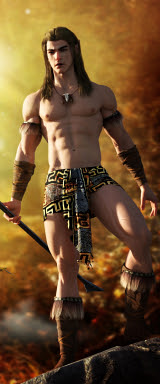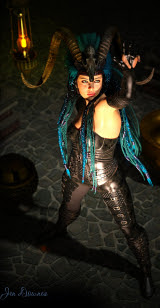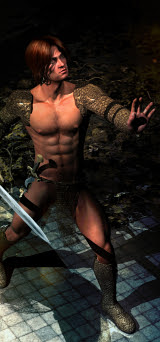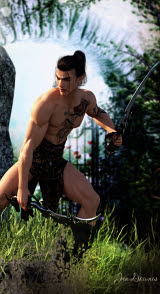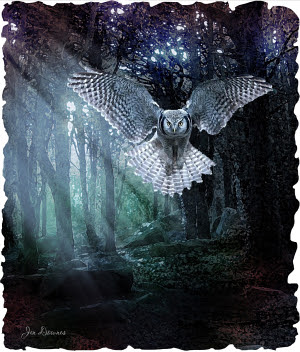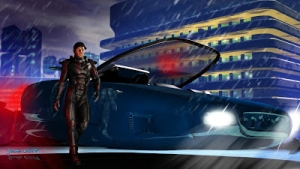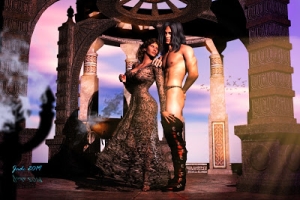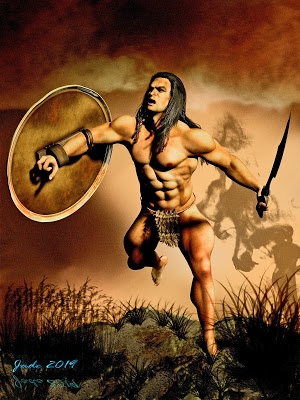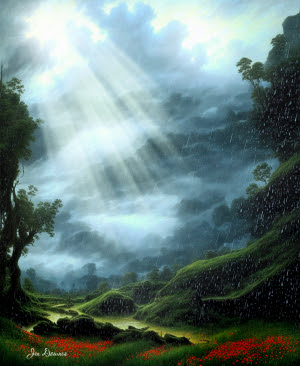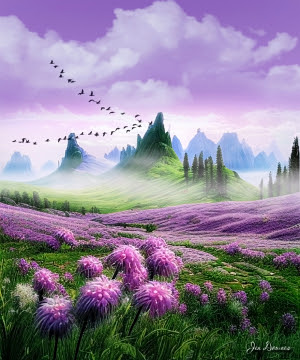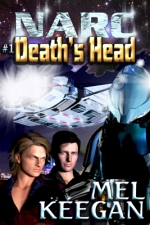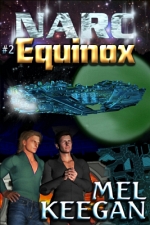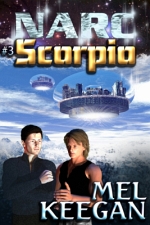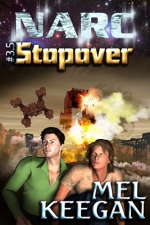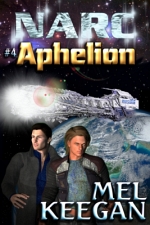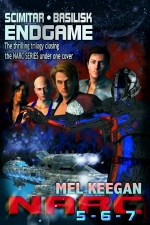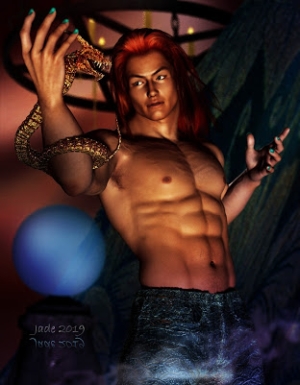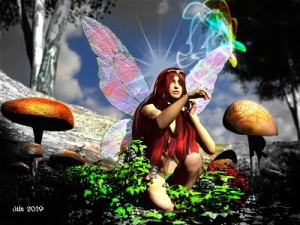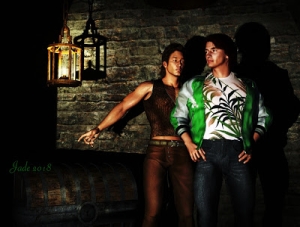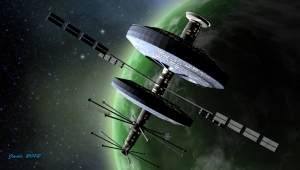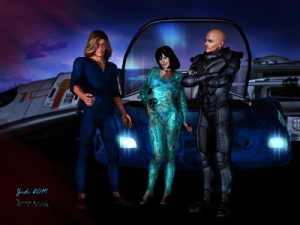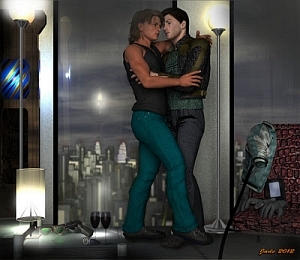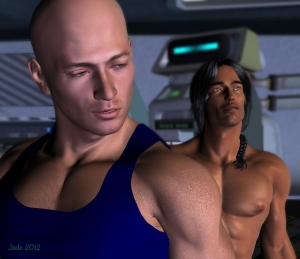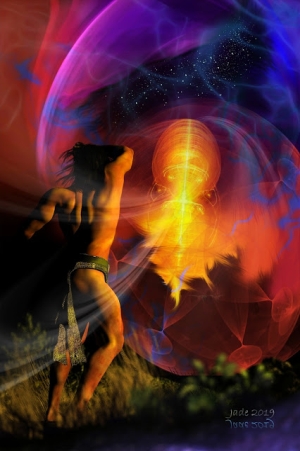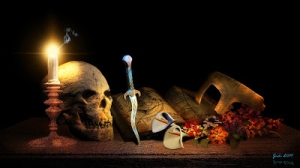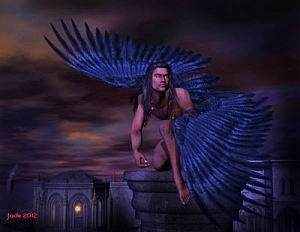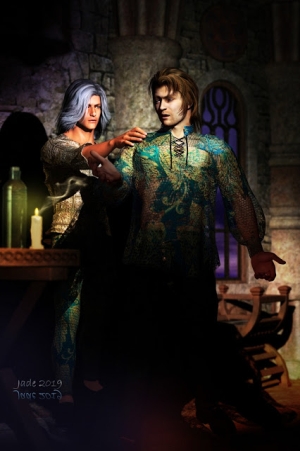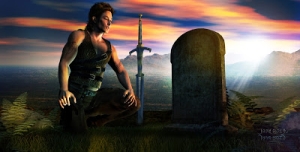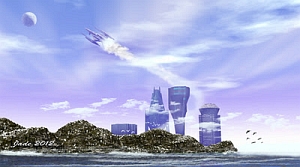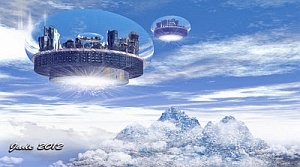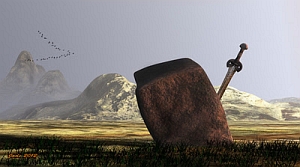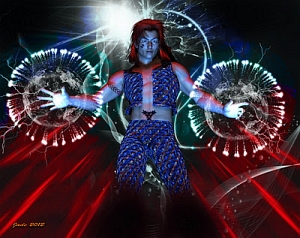click to see all images at large size...
These two renders are both Lux renders ... and boy, can't you tell? You know that's Jarrat and Stone, and you know they're the fantastic figments of Mel Keegan's incredible imagination., but there's a photogaphic quality to these images that makes your eye want to believe you're looking at real guys, maybe actors on a movie set -- and the closer you get to the image (or, the bigger it gets), the stronger the illusion becomes -- and even this detail shot,below, is not the full-size image -- click on the pic above to see it big...
In fact, I rendered this shot twice, once in DAZ, using the LightDome Pro II lighting sets and "sky sphere," which is a giant shell surrounding the whole scene, with the sky texture/image pasted on the inside of it; and then again in Lux...
Now, if you didn't have Lux, or just didn't want to mount the learning curve for a top-end render engine -- which, admittedly, is like trying to run up a wet slide, backwards -- then I would have to strongly and seriously recommend LightDome Pro. It's actually fantastic, and only falls short when you come to compare the results with something like Lux, which has the potential (if I can just get the details figured out) to generate the kind of results you see coming out of major studios. Take a look -- give this a click:
Left: a raytrace using LughtDome Pro II with 186 lights set automatically by the plug-in! Right: the Lux render with just one light which represents the sun. The raytrace fook 4 hours. The Lux rendender took 10.5 hours. Both of them needed a lot of post-work to redo, or unto, a number of anomalies, or "artifacts" which showed up in the renders -- and the little glitches were different in both pictures. The results are very different indeed. The photographic quality of the Lux render has a high wow factor, but you don't notice it so much till you get to the fine details, like human faces. If you just stepped back and looked at the whole shot, as rendered in LightDome with 186 raytraced skylights...
...as you can see, the integrity of the shot is already very, very high. And LightDome Pro costs just a few bucks, will run on an average computer, and renders in less than half the time, with a learning curve that can be climbed in about ten minutes flat. So --
Do I recommend LightDome? You bet! I'll be using it a lot, because a Lux render is something you set up before dinner, and you get your picture, for better or worse, in the morning. Sometimes you come back in the morning and find something that the piece can't be saved, no matter how clever you are in Photoshop, because the settings were wrong, but you wouldn't have seen them for four or five hours ... by which time you were sound asleep!
Also, Lux will not render the actual dome prop -- the giant sphere that encompasses the scene. The first time I set up this scene, I just imported it exactly as it had been rendered in DAZ, but with all the LightDome lights turned OFF and replaced with a single sun light, as Lux likes for its exteriors. Clicked "go," and came back in several hours to see what was going on. Gibberish. Turned OFF the skydome and went again, with the alpha channel set for the background.
The other thing Lux won't do is render a backdrop -- which is an image pasted in like wallpaper behind the shot, to become the sky or background. So you're always fiddling around with cycloramas, if you want the sky to be part of the image, or you're fiddling about with the alpha channel in Photoshop, to replace the black pixels with a background ... which doesn't work out so well, if your image has a lot of black pixels that are not in the background. You can waffle on for half an hour trying to get the background set properly. If you have the time and tenacity, the results are very, very rewarding, but sometimes you just don't have the time. In which case, SkyDome is going to be a marvelous alternative.
Am starting (and I stress, starting) to get the hang of Lux. I'm seeing (or think I'm seeing) how it actually works, and the program is just beginning to open its doors to reveal its inner mysteries. To get absolutely top-notch renders in Lux, though, takes days per images, rather than the images per day I'm used to achieving. For instance, in the detail shot here...
...you notice that the car's raised canopy didn't render with any, many, or very good reflections. Grrr. If I'd had time, I'd have gone back in, hiked the reflective property, and set it to re-render. Then hours later you come back and see if it's reflective enough, or too much. Adjust again. Rerender. Adjust again ... and so on. Time flies by. I'm sure I'll learn how to set all this up ahead of time ... it's part of the learning curve I likened to trying to run backwards up a wet slide in the rain! (The headlights, lamp glow and lens flare were all painted on in Photoshop -- but Lux will do these things "in camera." I just need to learn how.)
So at the moment -- and I'm the first one to admit this, in the interests of full disclosure! -- there's a lot of Photoshop fixing going on, to "save" renders and get useful pictures, without the re-re-re-rendering which would give me about one great picture a week at this stage in my development. But I'm definitely getting there.
My next project is to concentrate on skin tones in Lux, and get those beautiful, liquid, luminous tones I've been drooling about for eons in the work of various other artists who have a head start of years on me. They've all trodden this path, climbed this hill. Now it's my turn to plod and climb. At the same time, I need to be painting skinmaps, so can get exactly what I need ... for instance, it's very, very difficult to render Jarrat and Stone in the same shot, because the skinmap I'm using for Jarrat is actually too dark. He's tanned, but actually not as dark as he usually shows up, and especially not in the shots where he appears with Stone -- the reason being that the skinmap I'm using for Stoney is quite pale, and pretty accurate for the character, who's a Londoner by birth. If the lights and exposure are set up to favor Jarrat, Stone will wash out to ghostlike qualities; but if the lights and exposure are set up to favor Stone, Jarrat tends to turn bright orange!
So one of the first things I'll be doing is generating a specific skinmap for Jarrat which is adjusted for tone, pigmentation and detail, and this should make my depiction of Jarrat much more accurate, and it should also make it much easier to depict the two characters in the same shot. Can use this project as the test piece, and learn enough while doing it to be able to paint skinmaps specifically for certain characters. There's a lot to learn -- and it's going to be fun!
Jade, April 25 (Anzac Day downunder)


















